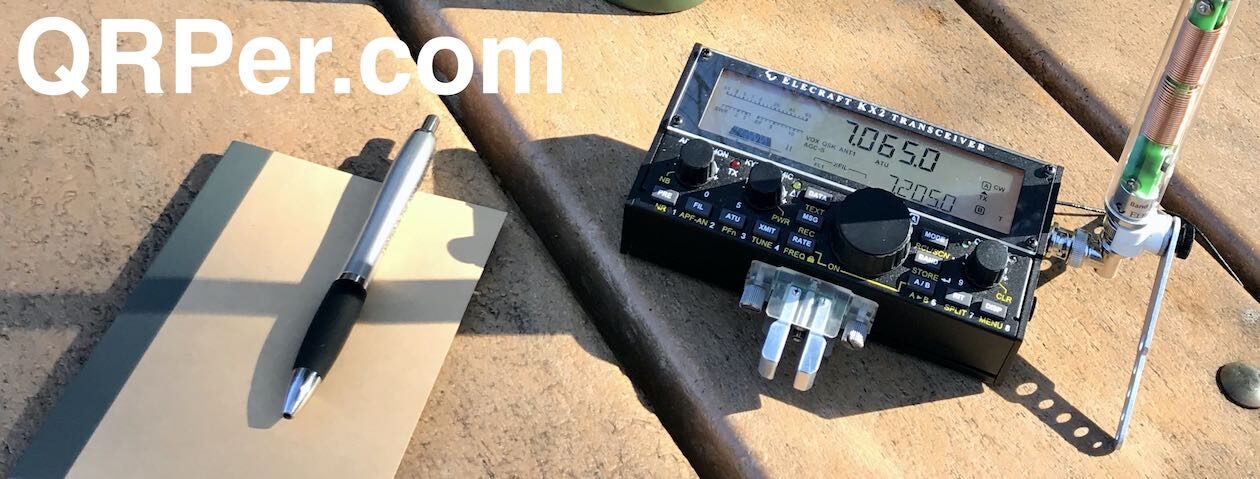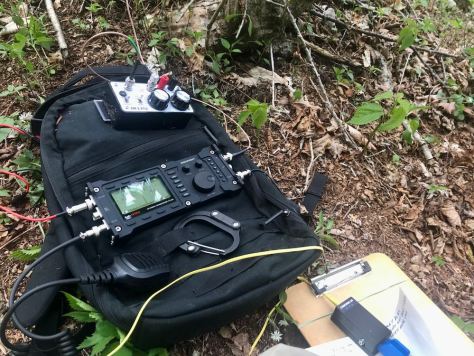 Last time I visited Table Rock Fish Hatchery–this activation–it was a struggle to get the ten contacts I needed for a valid activation. Propagation was horrible that day, making it a proper struggle.
Last time I visited Table Rock Fish Hatchery–this activation–it was a struggle to get the ten contacts I needed for a valid activation. Propagation was horrible that day, making it a proper struggle.
On Thursday, May 20, 2021, I thought I’d go back to the fish hatchery for another try! I really like the site: it’s open, has lots of trees, and the staff (and neighborhood dogs) are all very friendly.

Thing is, as I drove to Table Rock, my buddy Mike informed me that propagation took a nose dive. Earlier in the day, it had been reasonably stable, but he noted that POTA activators were struggling in the afternoon and the propagation numbers were in the dumps.

My secret weapon: The Chameleon CHA LEFS
 Shortly after I posted my “unboxing” video of the lab599 Discovery TX-500, Carl at Chameleon Antenna made a comment on my YouTube channel that he was going to send me their CHA LEFS (Lightweight End Fed Sloper) wire antenna since it’s resonant on 40, 20, 17, 15, 12 and 10 meters. In many ways, it’s ideally suited to pair with the TX-500 since this transceiver lacks an internal ATU. Side note: there is a cool project in the works called the DIY599 that adds a 60 watt amp and ATU to the TX-500 .
Shortly after I posted my “unboxing” video of the lab599 Discovery TX-500, Carl at Chameleon Antenna made a comment on my YouTube channel that he was going to send me their CHA LEFS (Lightweight End Fed Sloper) wire antenna since it’s resonant on 40, 20, 17, 15, 12 and 10 meters. In many ways, it’s ideally suited to pair with the TX-500 since this transceiver lacks an internal ATU. Side note: there is a cool project in the works called the DIY599 that adds a 60 watt amp and ATU to the TX-500 .
I had only recently received the CHA LEFS and had not yet taken it to the field. Table Rock was the perfect opportunity.
When I know in advance that propagation is poor, I try to make my portable set up as efficient as possible, so that’s when I 1.) make sure I pull out a resonant wire antenna and 2.) use a wire antenna with longer radiators. The CHA LEFS fits both of these bills.
The CHA LEFS has a 63 foot radiator made of 20 gauge PTFE antenna KEVLAR wire. The winder has a large efficient transformer to match impedance, and there is an inline coil to make the most of the 63′ radiator. They also include 50′ of Micro 90 paracord.
Like all Chameleon antennas I’ve used, it’s built to military specs.
Table Rock Fish Hatchery (K-8012)
 Table Rock is ideally-suited for a long-ish sloping wire antenna, too. The site has tall trees and open spaces that make stretching out the sloping radiator quite easy. Just watch those power lines!
Table Rock is ideally-suited for a long-ish sloping wire antenna, too. The site has tall trees and open spaces that make stretching out the sloping radiator quite easy. Just watch those power lines!
The CHA LEFS takes longer to deploy that end-fed antennas with a feedpoint near the ground. I find it quicker to deploy, however, than dipoles.
I deployed the LEFS by first stretching out its radiator wire in the direction I planned to deploy it.
Next, I connected the coax feedline to the SO-239 on the LEFS winder and stretched it in the opposite direction of the radiator. Why do this? It helps keep the radiator and coax from twisting together as I raise the winder/feedpoint into the tree.
This is not a difficult antenna to deploy as one person. Of course, if you have a helper, it’ll go even faster (I’ve yet to convince Hazel to help me with antenna deployment).
I had launched the arborist line quite high into a tree at the picnic table where I planned to operate. I was able to elevate the LEFS feedpoint/winder about 47′ into the tree.
I used the supplied paracord to attach the radiator to a nearby branch. The end of the sloper was perhaps 6 feet off the ground (if memory serves).
Gear:
- lab599 Discovery TX-500
- Chameleon CHA LEFS
- CW Morse “Pocket Paddle”
- GoRuck Bullet Ruck
- Bioenno 3 aH LiFePo Battery (Model BLF-1203AB)
- Arborist throw line
- Rite In The Rain Weatherproof Cover/Pouch (affiliate link)
- Jovitec 2.0 mm Mechanical Pencil (affiliate link)
- Muji A6 Notepad (affiliate link)
On The Air
 Knowing how poor conditions were from real-life K8RAT observations, I didn’t expect to actually validate my activation by logging the required 10 contacts. As I stated in my activation video, I was fully prepared to walk away with three or four contacts–I didn’t have a few hours to burn on an activation. I was simply happy to play with a new antenna, the TX-500, hang with the local canine welcome committee and enjoy the fine weather.
Knowing how poor conditions were from real-life K8RAT observations, I didn’t expect to actually validate my activation by logging the required 10 contacts. As I stated in my activation video, I was fully prepared to walk away with three or four contacts–I didn’t have a few hours to burn on an activation. I was simply happy to play with a new antenna, the TX-500, hang with the local canine welcome committee and enjoy the fine weather.
First, I hopped on 40 meters and discovered the LEFS provided a perfect 1:1 match on 7063 kHz. Very promising!
Next, I started calling CQ and the Reverse Beacon Network functionality of the POTA spots page must have quickly auto-spotted me.
Within 13 minutes, I logged six contacts! I was impressed. Mike (K8RAT) was in that first six contacts and he later told me it was one of the strongest signals he’d ever heard from me at a POTA activation. He asked what I was using as an antenna that day and said, “it was working!”
Next, I moved to the 30 meter band and worked K8RAT again (a rarity on 30 meters!) along with four other stations.
I ran out of time, so called it quits with 11 stations logged.
I did not expect to not only walk away with a valid activation, but to have completed it in such short order.
QSO Map
Here’s the QSO Map of my contacts all made with 5 watts of power:
Video
Here’s my real-time, real-life, no-edit video of the entire activation. Next time I take the LEFS out, I’ll try to remember to include setting it up:
Loving the CHA LEFS!
 Talk about good first impressions!
Talk about good first impressions!
As Carl suggested, I’m going to keep the CHA LEFS tucked away along with my PackTenna EFHW in the Discovery TX-500 pack.
When conditions are poor, I’ll spend the modest amount of extra time deploying this fine antenna.
The only CHA LEFS criticism I noted–and it’s a minor one–is that the in-line trap/coil isn’t very low-profile and takes a little attention to make it fall in the right spot when reeling the antenna up post-activation. Seriously. A minor criticism and I’m guessing Chameleon has a reason for it being on the large size–likely for power handling reasons.
Field Day is coming up, and I think I’m going to make the CHA LEFS one of Team Baklava‘s main antennas (Team Baklava = my buddy N3CZ and me!).
As for the CHA LEFS, I highly recommend it!















































